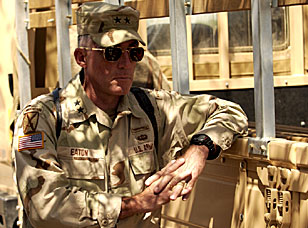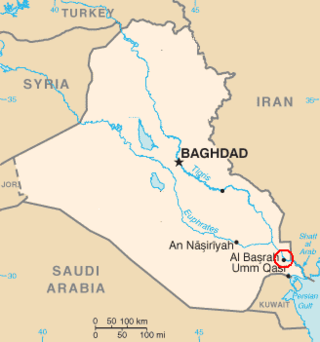Related Research Articles
The Islamic National Army or referred to as the Afghan Army, is the land force branch of the Armed Forces of the Islamic Emirate of Afghanistan. The roots of an army in Afghanistan can be traced back to the early 18th century when the Hotak dynasty was established in Kandahar followed by Ahmad Shah Durrani's rise to power. It was reorganized in 1880 during Emir Abdur Rahman Khan's reign. Afghanistan remained neutral during the First and Second World Wars. From the 1960s to the early 1990s, the Afghan Army was equipped by the Soviet Union.

The Iraqi National Guard was an armed force originally established by the United States Coalition Provisional Authority. Following the 2003 invasion of Iraq, CPA Administrator Paul Bremer disbanded the apparatus of the Iraqi Armed Forces through Coalition Provisional Authority Order 2. U.S. divisions of Combined Joint Task Force 7 then began recruiting and training auxiliary forces, the Iraqi Civil Defense Corps, in order to combat the insurgency.

The Iraqi Ground Forces, or the Iraqi Army, is the ground force component of the Iraqi Armed Forces. It was known as the Royal Iraqi Army up until the coup of July 1958.
Civil Affairs (CA) is a term used by both the United Nations and by military institutions, but for different purposes in each case.

The Iraqi Police (IP) is the uniformed police force responsible for the enforcement of civil law in Iraq. Its organisation, structure and recruitment were guided by the Coalition Provisional Authority after the 2003 invasion of Iraq, and it is commanded by the reformed Iraqi Ministry of the Interior. "IP" refers to the Iraqi Police, and "ISF" to the broader Iraqi security forces. The current commander of the Federal Police Forces is Lieutenant General Raed Shaker Jawdat.
A Military Transition Team or Transition Team, commonly abbreviated as MiTT, in the context of the United States Military, is a 10 – 15 soldier team that trains foreign national and local security forces. The term has been used in the "War on Terror" to designate groups training the Iraqi Security Forces in particular. By comparison, Afghan Army and other Afghan security forces are mentored and trained by US Embedded Training Teams (ETTs) and the Operational Mentoring and Liaison Teams (OMLTs) of other nations.

The Iraqi Armed Forces are the military forces of the Republic of Iraq. They consist of the Iraqi Army, the Iraqi Air Force, and the Iraqi Navy. Along with these three primary service branches, there exists the Iraqi Special Operations Forces. The President of Iraq acts as the supreme commander of the military as outlined by the national constitution.
Multi-National Security Transition Command – Iraq (MNSTC-I) was a training and organizational-support command of the United States Department of Defense. It was established in June 2004. It was a military formation of Multi-National Force – Iraq responsible for developing, organizing, training, equipping, and sustaining the Iraqi Ministry of Defense (MoD), with the Iraqi Armed Forces, including the Iraqi Counter Terrorism Service; and the Ministry of Interior (Iraq) with the Iraqi Police and Border Enforcement, Facilities Protection, and other forces. It was headquartered in the International Zone in Baghdad at Phoenix Base, a former elementary school.

Below is an estimated list of the major units deployed within the Multi-National Force – Iraq and other United States military units that were operating in Iraq under the U.S. Central Command (USCENTCOM) in 2009, during the Iraq War.

Camp Taji, also known as Camp Cooke, is a military installation used by Iraqi and Coalition forces near Taji, Baghdad Governorate, Iraq. The camp is located in a rural region approximately 27 km (17 mi) north of the capital Baghdad.

Embedded Training Teams or ETT is the term used by the US military since 2003 to describe conventional forces used to train and mentor Afghan forces. They were formed in 2003 under Task Force Phoenix. Although ETT refers to the Embedded Training "Team", members of the team itself commonly refer to themselves as "ETTs"

Paul D. Eaton is a former United States Army officer who commanded the operations to train Iraqi troops during Operation Iraqi Freedom. Eaton served in that capacity between 2003 and 2004, and then returned to the US to become Deputy Chief of Staff for Operations and Training, United States Army Training and Doctrine Command, Fort Monroe, Virginia. He previously served as Senior Adviser to the now-defunct National Security Network, a Washington, D.C.-based think tank focused on foreign policy and defense issues.

The Civilian Police Assistance Training Team or CPATT is a multinational advisory team operating within the US-led coalition in Iraq to rebuild the Iraqi Police.

The Battle of Basra began on 25 March 2008, when the Iraqi Army launched an operation to drive the Mahdi Army militia out of the southern Iraqi city of Basra. The operation was the first major operation to be planned and carried out by the Iraqi Army since the invasion of 2003.

The NATO Training Mission-Iraq (NTM-I) was established in 2004 at the request of the Iraqi Interim Government under the provisions of UN Security Council Resolution 1546. The aim of NTM-I was to assist in the development of Iraqi security forces training structures and institutions so that Iraq could build an effective and sustainable capability that addressed the needs of the nation. NTM-I was not a combat mission but was a distinct mission, under the political control of NATO's North Atlantic Council. Its operational emphasis was on training and mentoring. The activities of the mission were coordinated with Iraqi authorities and the US-led Deputy Commanding General Advising and Training, who was also dual-hatted as the Commander of NTM-I. The mission came to an end in December 2011.
The NATO Training Mission-Afghanistan (NTM-A) was a multinational military organisation, activated in November 2009, tasked with providing a higher-level training for the Afghan National Army (ANA) and Afghan Air Force (AAF), including defense colleges and academies, as well as being responsible for doctrine development, and training and advising Afghan National Police (ANP). The commanding officer was dual-hatted and commanded both NTM-A and Combined Security Transition Command – Afghanistan (CSTC-A) and reported to the Commander of ISAF.

The Ground Forces Command at Victory Base Complex near Baghdad Airport was the most important fighting formation in the Iraqi Army. The headquarters of the Iraqi Ground Forces Command and the Iraqi Joint Forces Command are the same entity.

The 5th Division is a military formation of the Iraqi Army. The division is currently deployed in eastern Iraq – predominantly Diyala Governorate. Following the losses suffered by the Iraqi Army during fighting in the ISIL campaign in Northern Iraq, the Iraqi security forces became increasingly reliant on non-state militia units – the Popular Mobilization Forces. As of October 2015, Reuters reported that the 5th Division reported to the PMF chain of command, instead of the official military hierarchy.

The Iraqi Civil Defense Corps was an Iraqi armed formation created by the Coalition Provisional Authority (CPA) which existed in 2003–2004. The ICDC was controlled by Combined Joint Task Force 7. The idea originated from the 101st Airborne Division as a means of using unemployed former Iraqi military personnel and tribal militias to supplement the scarce U.S. military footprint.

The Junior Reserve Officers' Training Corps is a federal program sponsored by the United States Armed Forces in high schools and also in some middle schools across the United States and at US military bases across the world. The program was originally created as part of the National Defense Act of 1916 and later expanded under the 1964 ROTC Vitalization Act.
References
- 1 2 Wright & Reese 2008, pp. 433–434.
- ↑ John Pike. "New Iraqi Army (NIA)". Archived from the original on 6 October 2014. Retrieved 11 October 2014.
- ↑ https://www.globalsecurity.org/military/library/news/2004/01/mil-040121-dod01.htm
- 1 2 Wright & Reese 2008, p. 436.
- ↑ Allen, Patrick (8 February 2006). "New Iraqi Air Force boosted by aircraft and joint operations". Jane's Defence Weekly . p. 31.
- ↑ "Prepared Statement before House Subcommittee on National Security, Emerging Threats, and International Relations" (PDF). reform.house.gov. Archived from the original (PDF) on 1 May 2006. Retrieved 14 January 2022.
- Rathmell, Andrew; Oliker, Olga (2005). Developing Iraq's security sector: the coalition provisional authority's experience (MG-365-SD) . Santa Monica: Rand Corporation. ISBN 0-8330-3823-0. Et al.
- Wright; Reese (2008). On Point II: Transition to the New Campaign: The U.S. Army in Operation Iraqi Freedom May 2003-January 2005. Ft Leavenworth, KS: Combat Studies Institute Press.